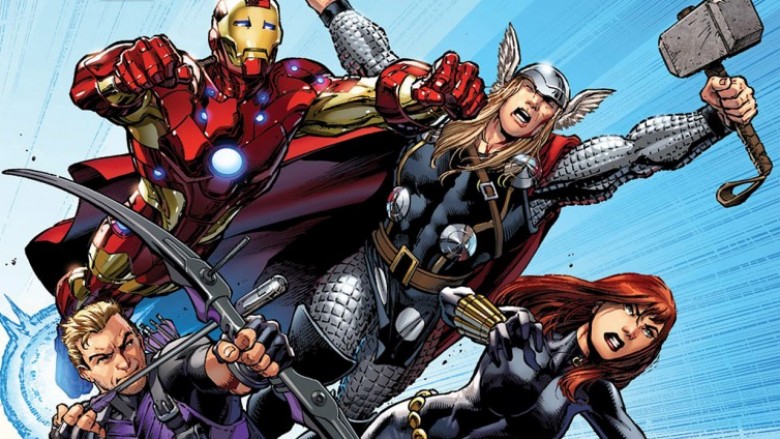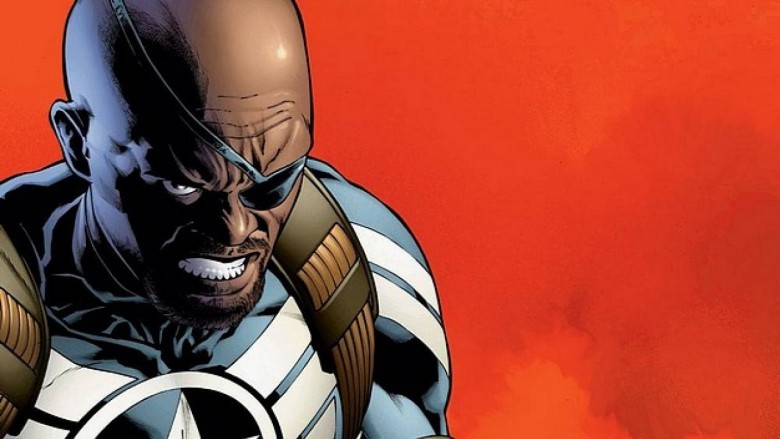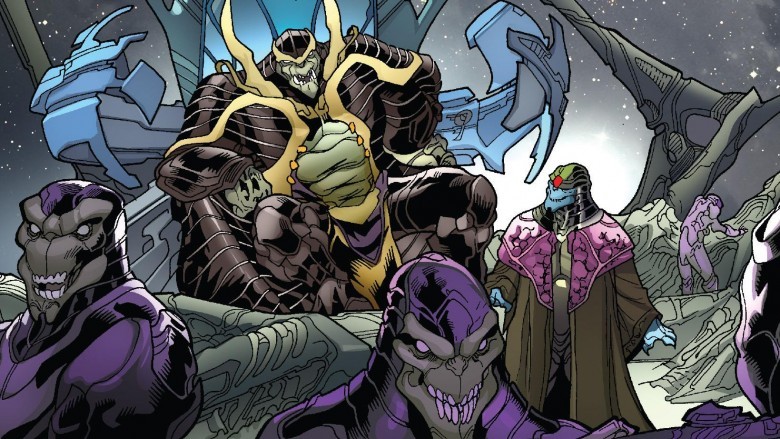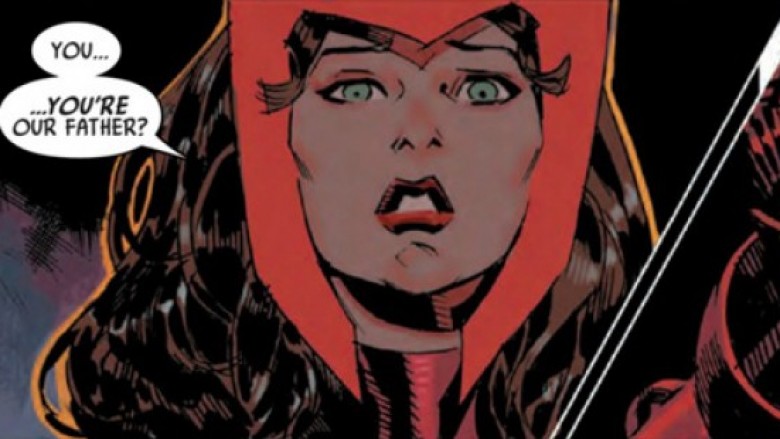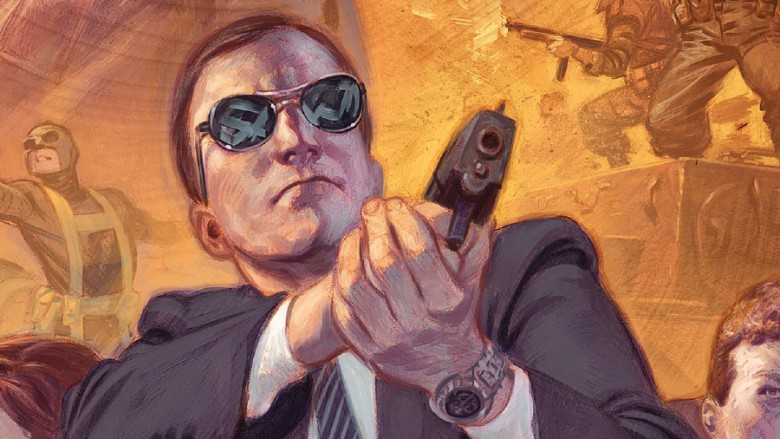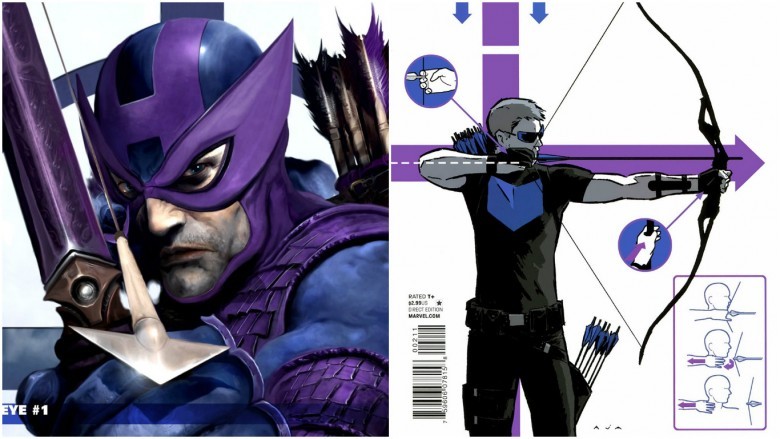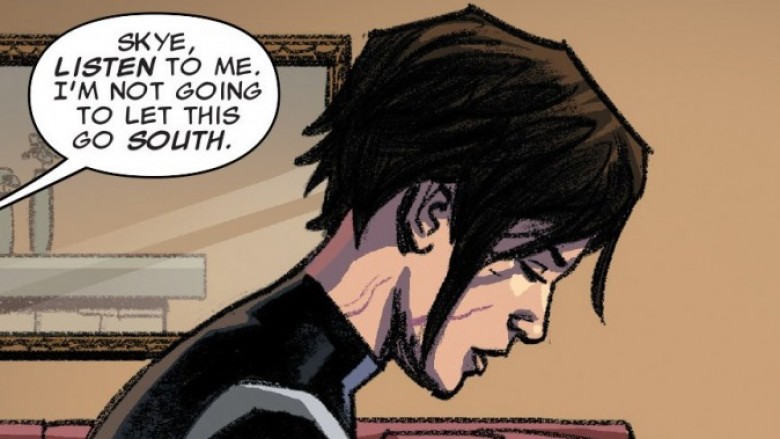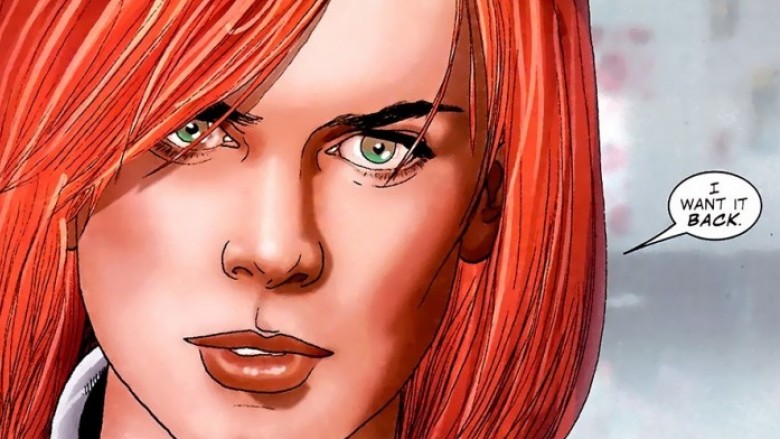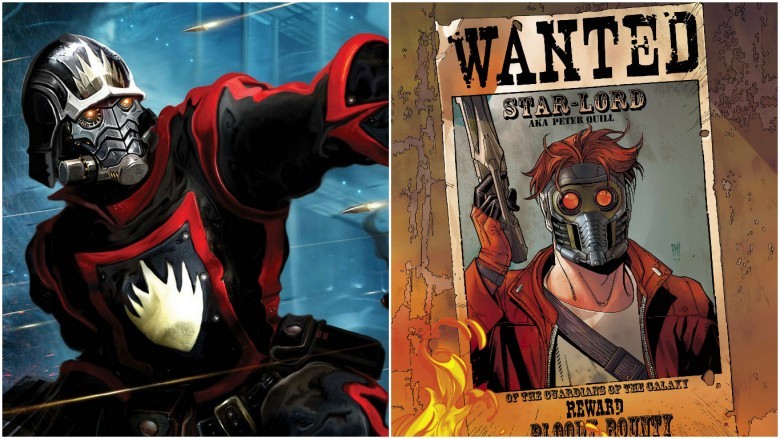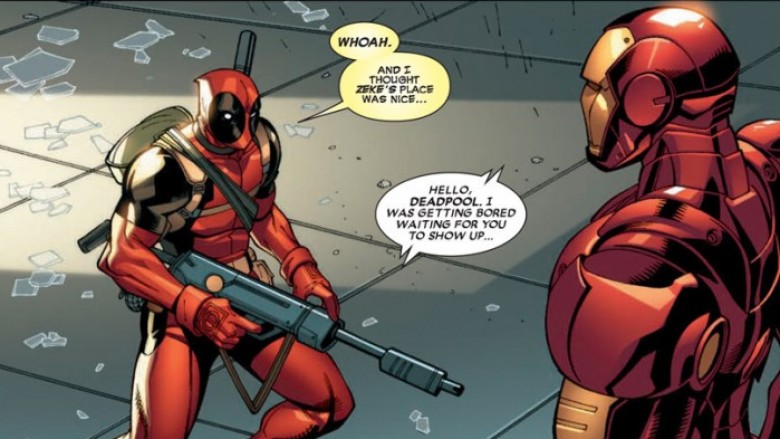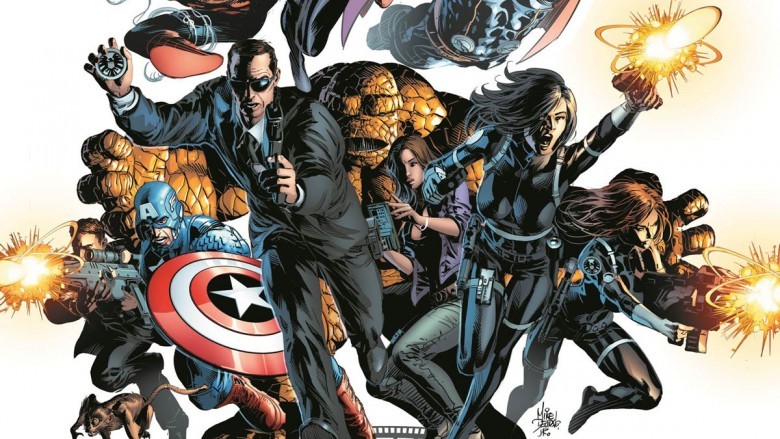Ways The MCU Changed The Comics It Comes From
Everyone knows that their favorite comic characters and storylines get changed when they're adapted into movies. This has certainly been the case for the Marvel Cinematic Universe. While the movies are generally faithful to their comics characters, there have been changes as minor as wardrobe and as major as changing who created Ultron. But it also works the opposite way: characters in new comic releases are rewritten, costumes are changed, and entirely new personalities are given to decades-old characters in order for them to match their big-screen counterparts. Here are just a few of the ways that the MCU has changed the Marvel Comics universe.
Nick Fury
Of all the entries on this list, Nick Fury has possibly the strangest story. The original Nick Fury of Marvel's proper comics universe was a white man. How white are we talking? He was played by David Hasselhoff in an entirely forgettable made-for-TV movie. Then came the Ultimates comics universe. These comics were meant to be an edgier, modern take on Marvel's most popular characters while also providing an easy jumping-on point for new readers, and they introduced Nick Fury as a black man. With no way of knowing that their comic series would become a huge inspiration for the biggest superhero film franchise in history (this was in 2001), writer Mark Millar and artist Bryan Hitch designed their new Fury as a picture-perfect Samuel L. Jackson...without even asking Jackson for permission to use his likeness. When the Marvel Cinematic Universe got around to casting for their on-screen Fury, Jackson was the obvious choice. But this left Marvel Comics with a problem: won't new readers be confused when they open a regular Marvel comic and see a white Nick Fury?
This led to the creation of Nick Fury, Jr. This character is the biological son of the familiar Nick Fury from the original comics. While he doesn't have the ultra-high rank of his father, he is portrayed with a solid resemblance to Samuel L. Jackson as he was portrayed in the popular Avengers movies. And while the comics make it clear that he is not truly replacing all of the roles filled by his famous father, Marvel has made things much easier for new readers by having a black Agent of S.H.I.E.L.D. named Nick Fury who regularly works with the Avengers.
The Chitauri
The Chitauri are a race of aliens that are also rooted in the Ultimates universe, though they followed their own weird path to the mainstream Marvel Comics universe. In the Ultimates comics, the Chitauri were pretty blatantly a stand-in for the shape-shifting Skrulls, the villains that most often clash with the Fantastic Four. And in those comics, the Chitauri are very Skrull-like, infiltrating governments and agencies with their shape-shifting powers and all operating pretty autonomously. When Joss Whedon wrote and directed The Avengers, he decided to use the Chitauri, but pretty much in name only. They were not shape-shifting or self-determining, but seemed more like a techno-organic hive mind of creatures.
Of course, Avengers became an absolute blockbuster of a movie, and that popularity eventually rippled into mainstream Marvel comics. Thus, in the "real" universe of our familiar heroes, the Chitauri were introduced. They pretty much look and act exactly like their cinematic counterparts, so new readers who want to see the Avengers continue their 2012 cinematic fight on the printed page can do so. The actual origin of these aliens, as an offshoot of the Skrulls in the Ultimates universe, is nothing but a distant memory.
Scarlet Witch and Quicksilver
Scarlet Witch and Quicksilver represent something of a cinematic anomaly when it comes to the ongoing struggle of which film company has the rights to which characters. The two were introduced in Marvel Comics as mutant henchmen of Magneto, and they later found out that Magneto was their father. However, they have been on-again, off-again members of the Avengers for decades. Thus, a bizarre arrangement was made: 20th Century Fox can use these characters as mutants and as the children of Magneto. Disney-owned Marvel, meanwhile, can use the characters, but they must not refer to them as mutants and can never mention Magneto's name. Thus, in the MCU, Scarlet Witch and her brother are simply humans enhanced by Hydra. Eventually, some of this MCU rewriting of the characters' histories filtered into the comics themselves.
During a truly bizarre storyline event known as "Axis," Scarlet Witch is turned evil by a magic whammy that basically turns good guys bad and bad guys good. She eventually gets possessed and her powers are used to undo this weird spell, but along the way, she learns that Magneto is not her biological father. Furthermore, she learns that she and her brother are not mutants but are instead the result of scientific experiments (albeit experiments by The High Evolutionary and not Hydra). And just like that, the MCU's legal struggles drastically undid decades of printed history.
Agent Coulson
The character of Phil Coulson, played by actor Clark Gregg, is one of the most consistently entertaining parts of the MCU. The character was introduced in Iron Man back in 2008, and Coulson initially served as the main glue holding the cinematic universe together, making appearances in the various MCU movies leading up to Avengers. In that movie, the character was seemingly killed by Loki, but then the character was resurrected (figuratively and literally) to headline the Agents of S.H.I.E.L.D. TV show, making Coulson the de facto face of small-screen MCU. Given both his popularity and his prominence, it was a given that Agent Coulson would eventually pop up in Marvel Comics.
The character of Coulson was introduced into the proper Marvel Comics universe as an Army Ranger who serves alongside Nick Fury, Jr. He and Fury join S.H.I.E.L.D. around the same time and, in a somewhat ironic twist, both initially report to Daisy Johnson, whose character in the MCU (initially introduced as Skye) begins by working under Coulson and the elder Nick Fury. While Coulson hasn't had too many major comic adventures yet, he has served as an Avengers liaison who works closely with Hawkeye and Black Widow, further mirroring his onscreen counterpart.
Hawkeye's costume
The subject of how a comic character's costume will look on the big screen is something that is sure to cause a debate among hardcore fans. Some people think that costumes need to be given a more realistic and modern look, which leads to the black-leather fest that was the first X-Men movie. Others think the world is ready for brightly colored spandex, pointing to the popularity of TV shows such as The Flash and Supergirl. One thing everyone can agree on, though, is that Hawkeye's original costume is terrible. It's bright purple, with a weird Wolverine-looking mask that hardly seems conducive to taking careful aim. When he's introduced into the MCU, Hawkeye has no mask and wears a simple black uniform with a splash of the original color. This outfit is such an improvement that it eventually landed in the Marvel Comics universe.
Hawkeye's design in Matt Fraction's amazing run on the solo Hawkeye series is an even more minimalist version of the movie design. In these comics, Hawkeye's complex old costume has been replaced with a simple black shirt with a purple icon, black pants, and some sunglasses. The design is especially fitting for a series intended to focus on what Hawkeye does when he's not busy being an Avenger. However, the fact that the look premiered in the same year as The Avengers made it pretty clear that the movie's Hawkeye had affected the comic design.
Changes to Daisy Johnson
One of the most popular characters in the Agents of S.H.I.E.L.D. television show also started out as one of its biggest mysteries. The character known as Skye began the series not knowing much about her background or parentage. She eventually finds out about her Inhuman mother and rage-monster father and discovers her own Inhuman power to create earthquakes as well as her real name: Daisy Johnson. This confirmed growing fan theories that the mysterious Skye was an existing Marvel Comics character whose code name was Quake. Most of the elements of the comic character were already in place and utilized accurately in the MCU. However, there were some minor ways that her live-action show changed her comics character.
The television show established that her father was the comics villain Mr. Hyde. This had not previously been established for the comics, but the comics later made it canon after it was introduced on the television show. The comics also found a creative way to integrate the name "Skye." That name had previously been exclusive to the show, but the comics revealed that it was a nickname that Coulson had started calling Daisy because her character had been spending a lot of mission time in space lately.
The regression of Pepper Potts
When it comes to movies and comic books, comic book writers are often put into an uncomfortable position. In a perfect world, the movies will serve to bring in some brand new comic readers. However, those readers are likely expecting a comics world that is mostly in line with the movie they've just seen. Movies like Iron Man tried to go back to the roots of the character and explain his origin, but in the comics universe, those characters were dramatically different after decades of growth and development. Thus, characters are often shuffled back into their old roles in order to accommodate new readers. This is exactly what happened to the character of Pepper Potts.
Though Gwyneth Paltrow imbued the role with an independent twinkle, she started out in the MCU as Tony Stark's personal assistant. This is in line with her comic book origin, but by the time Iron Man came out, she had thoroughly moved on. For instance, she had married (and divorced) Happy Hogan and even had a superhero moniker, "Hera," serving as a kind of Oracle-like character for the government super-team The Order. Nonetheless, after the Iron Man movie came out, she became Tony Stark's personal secretary once again in the comics. And while her comics persona would go on to be more independent later on, it doesn't change the fact that Marvel gave her a decades-old downgrade in response to their first cinematic success.
Star-Lord's look
After Guardians of the Galaxy came out, the character of Star-Lord became iconic. Whereas fans would have once had the same reaction to his name that characters in the movie had ("who?"), he quickly became a global phenomenon. And this wasn't just for the abs he was packing under his outfit, as Star-Lord's space-western style red coat was an instant icon. Of course, the handful of comics fans who remembered Star-Lord before the movie came out would barely have recognized him, as his outfit was changed almost entirely for the film. And, after the runaway success of the movie, Star-Lord's comic outfit was changed to more closely resemble the film uniform's appearance.
The movie really plays up the idea of the Guardians in general and Peter Quill in particular as being outlaws on the run from the law. In the comics, however, Star-Lord pretty much IS the law, serving as a kind of policeman in space with a uniform that matches the job. After the movie debuted and became a hit, the comic Star-Lord started rocking the red trench coat look that Chris Pratt had made so popular. And while the character would continue to have different styles in different comics, that trench coat was added to the rotation solely because of the success of the film.
Iron Man's personality
At this point, it's pretty much impossible to imagine the character of Tony Stark without imagining Robert Downey, Jr. The sarcastic and snarky actor has made Tony Stark the go-to guy in the MCU for puns and blunt remarks. It's cute, it's funny...and if we're being completely honest, it's not really who Tony Stark was designed to be. The character was designed as a brilliant engineer and capitalist in the '60s...being sassy and sarcastic doesn't really fit the model for a billionaire businessman with an alter ego any more than it fits someone like Bruce Wayne. Nonetheless, after the success of 2008's Iron Man, the comic book Stark became more like his cinematic counterpart.
This all started with Matt Fraction's run on The Invincible Iron Man. Fraction started writing the comic before the movie came out, but after it did, his Tony Stark pretty much embodied the voice of the movie Stark. Suddenly, Stark is the one who cracks jokes in the face of danger, as he does in front of an incredulous Mariah Hill. And after Fraction broke the seal, later writers continued to try to capture Downey's unique voice on the printed page, meaning that Stark has now become the resident funny man (at least, when Peter Parker is not around).
The Agents of S.H.I.E.L.D.
While we have touched on the introduction of Coulson and the changes to Daisy Johnson because of the MCU, the entire Agents of S.H.I.E.L.D. show has had a major impact. This is because Marvel eventually created an Agents of S.H.I.E.L.D. comic book to incorporate many of the unique characters from the television show into the main Marvel Comics universe. Thus, while the comic has featured characters that already existed prior to their MCU incarnations (such as Deathlok and Quake) and MCU characters that were already brought over to the comics previously(such as Coulson), it introduced Agents Fitz, Simmons, and May. And while the team hasn't had a great many adventures in their newest incarnation, we can now finally see these television characters interacting with the various heroes and settings that a television show rarely has the budget to bring to life.
